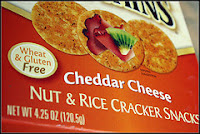For me stevia is the saving grace for all of us sweet-cravers as it contains zero calories, is totally alkaline, and has a plethora of healthful properties way beyond its ability to dulcify our foods and beverages!
Coming from the chrysanthemum family, stevia grows wild in Paraguay and Brazil and is also cultivated in Japan, China, Mexico, California, and Southern England. Used since pre-Columbian times to sweeten the native tea called mate, the Italian traveler Antonio Bertoni wrote about it much later in 1887 as the sweetener used by many native South American tribes.
Thirty times sweeter than sugar, stevia contains sweet glycosides that are not metabolized by the body, which means they won’t add extra calories. Despite its highly sweet taste, in its unadulterated form stevia doesn’t adversely affect blood glucose levels and can even be used by diabetics and hypoglycemics! Additionally, stevia actually helps to normalize blood sugar levels. It will also lower blood pressure if you have this condition while not affecting normal levels if you don’t. Here are some other health attributes of stevia:
· Functions as a tonic to the entire body
· Increases energy
· Increases mental acuity
· Inhibits the growth and reproduction of specific types of bacteria and other infections organisms
· Helps prevent tooth decay, gum disease, and oral health in general (add to toothpaste or dilute with water for mouthwash)
· Helps prevent the onset of colds and flu
· Helps with weight management and loss
· Reduces cravings for sweets and fatty foods (can be taken before meals to reduce hunger)
· Helps restore lost hunger if obstructions in the hypothalamus and stomach exist
· Improves digestion
· Improves gastrointestinal function
· Helps reduce cigarette and alcohol cravings
Stevia, Skin, and Hair
Stevia is also effective in maintaining healthy skin and hair. It can be used as a facial mask by smoothing a paste made of the powder or crushed leaves and water over the skin and letting it dry for a half an hour or so. Rinse it off and you will feel how it has tightened and softened the skin, smoothing out wrinkles and healing blemishes. You can also place a few drops of stevia concentrate directly on a blemish, sore, cut, or scratch and impressive healing will occur. Stevia is sometimes added to organic soaps and shampoos as it helps to eliminate dandruff and sooth scalp problems, making hair more lustrous. You can add it yourself to your favorite shampoo.
An Abundance of Nutrients
The stevia leaf contains an abundance of nutrients such as proteins, fiber, carbohydrates, iron, phosphorus, calcium, potassium, sodium, magnesium, zinc, rutin, vitamin A, vitamin C and an oil that contains a host of other healthful elements.
Buying Stevia
Stevia, like most things, can be of poor or high quality. The poorer the quality of the leaves, the more bitter it will taste. A high quality manufacturer will make sure that stevia’s processing is minimal and done with consciousness. In this regard it will taste slightly licorice-y. I buy my stevia from a top-notch health food store in powder form. It is a beautiful green and tastes divine and you only need a very tiny amount as a little goes a very long way!
Stevia comes in tea bags, as a loose tea, in ground form, in tablets, or as a liquid concentrate. Quality will depend on soil conditions, the amount of irrigation and sunlight, purity of the environment, farming and harvesting practices, processing, and storage. Make sure you buy the most reputable brand to get the most out of the product.
Stevia doesn’t break down in heat like honey or artificial sweeteners do. This means you can cook and bake with it and be sure that you are getting all the nutritional components you need.
The FDA vs. Scientific Research
Though the FDA has listed stevia as an unapproved food additive, it is allowed as a food supplement, but not as a sweetener. That being said, researcher and physician Dr. Daniel Mowrey has said vis a vis his extensive research on the pros and possible cons of stevia:
"More elaborate safety tests were performed by the Japanese during their evaluation of stevia as a possible sweetening agent. Few substances have ever yielded such consistently negative results in toxicity trials as have stevia. Almost every toxicity test imaginable has been performed on stevia extract [concentrate] or stevioside at one time or another. The results are always negative. No abnormalities in weight change, food intake, cell or membrane characteristics, enzyme and substrate utilization, or chromosome characteristics. No cancer, no birth defects, no acute and no chronic untoward effects. Nothing."
So there you have it!
I say, let’s break the sugar addiction by turning to Stevia, the sweetest of the sweet, getting healthier in the process!















